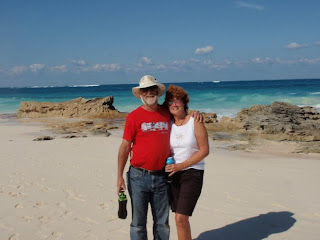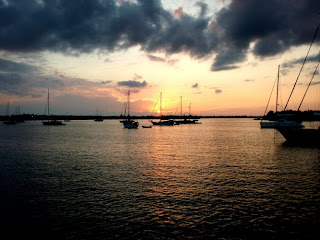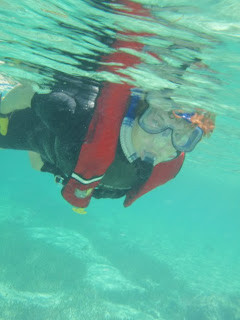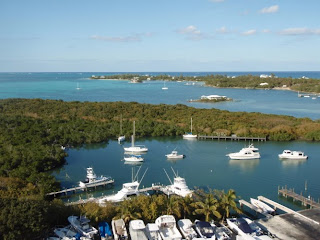To my way of thinking, the steering of the R&B Haven was unusual in its need to be constantly countersteered in order to make the boat go straight. Once a turn was initiated either through an external force such as a wave or by a slight turn of the rudder, the turn would continue until you countersteered - in spite of the fact that the rudder was centered. In the absence of intervention, often the rate of turn would even accelerate – all by itself.
This meant that if the boat yawed to the left, you had to first steer to the right and then as you caught the yaw, you had to immediately start turning the wheel towards the neutral position in order not to oversteer. As the boat swung to the right, back towards the desired course, you then had to actively countersteer to the left in order to slow and then to stop the swing to the right at the desired heading. You then had to turn the wheel back to the right and back to the neutral position before an undesired turn to the left was initiated.
I don't know if this is normal for a Gulfstar 38 or if it is because of the cockpit which was added at the factory without repositioning the rudder or the prop.
In calm seas, I could learn to anticipate and to steer in a relatively straight course. It required constant attention, however, and the autopilot could not learn to do this. At best, the autopilot would deviate about 10 degrees on either side of the desired course (20 degrees total). In a following wind, it was pretty hopeless. In following seas over 3 feet, when steering manually, I was very, very busy trying to maintain an even remotely straight course.
My good friend, Bruce, on advice of an old Newfoundland fisherman, suggested I consider modifying the rudder so that it become what is known as a “fishtail rudder”. Bruce's fisherman friend suggested a simple sounding solution: weld a piece of angle iron to the tailing edge of the rudder. There were two challenges to this solution: the rudder is fiberglass and welding to it is not easily done and secondly, it was underwater.
As a test, I cobbled something together made of aluminum extrusions. The idea was to clamp it to the trailing edge of the rudder as a proof of concept. Because we were then cruising in the Sea of Abaco where there are no large waves, it took me a while to get a round to it. Eventually, I did bolt it into place and then modified it to see if there was a more optimal solution.
The rest of this story will tell what I found.
When my friend Bruce originally suggested this rudder modification, I thought he had consumed too much “Newfie” Screech (rum) and had taken leave of his senses. Attaching a piece of angle iron to the trailing edge of a rudder made no sense to me at all. I thought it would create a lot of unnecessary drag and that would be it.
Upon doing some internet research, I found that the idea has been around for a while and apparently is catching on in ship design. Apparently, it makes the rudder almost as effective as an articulated rudder, but without the complications.
The rudder on the R&B Haven is about 2 ½ feet deep and about 1 ½ feet fore and aft. The trailing edge is about ¾ inches wide. The attachment I made clamped to the trailing edge of the rudder. It then narrowed in at a 30 degree angle (on each side) to its narrowest section, approximately 3/8 inches thick. From here, it flared out at a 30 degree angle to a total width of ¾ inches. From here, it flared an additional 15 degrees (45 degrees off the centerline or 90 degrees total) so that the total width of the flare was about 1 ¾ inches.
A sketch showing 3 design iterations follows.
Photo of rudder with fishtail attachment installed.
Photo of trial fishtail attachment installed after trail 3.
Photo taken from underneath boat.
With the orignl attachment in place, the helm felt very heavy. Steering control was greatly improved but I had a feeling that we might be losing 1/3 to ½ knot. It was difficult to tell, however, since we only used this configuration in 25 knot winds and our loss of speed may have been solely due to currents, waves and winds.
I then removed the tail sections of my little invention. The steering was still significantly better than before the fishtail was added to the rudder and there was no loss in speed in calm conditions. Also, the helm did not fee nearly so heavy. I seriously considered just leaving the rudder in this stage of development.
Rather than leaving well enough alone, I decided that while I had the chance, I really ought to try a third configuration where I straightened the last flaring pieces and reinstalled them. All of the flare was then at 30 degrees from the centerline. This configuration seems to perform exactly in the middle of the other two, exactly as you might expect. The only difference is that there is no apparent speed loss in calm conditions. In calm conditions under autohelm the boat weaves about 2 to 3 degrees to each side of its mean course. Going into waves, it performs extremely well, returning to its desired course quickly and will little overshoot when knocked off by a wave. In following seas, it still wanders a bit. These latter conditions are ones where the old rudder was completely hopeless. In moderate following or quartering seas (3 to 4 feet), it probably does at least as well as I do (plus or minus 10 degrees from the desired course) since its attention span is longer.
Wake in calm seas. This is a big improvement over the +- 10 degrees of previous hunt.
I am declaring this design a success!
Now I just have to replace the aluminum trial attachment with a permanent fiberglass fishtail. At the same time, I think I will add an endplate and will extend the front of the rudder a little in order to lighten the helm.
Bruce, thank you for passing on this crazy idea from a Newfie fisherman.

























































































